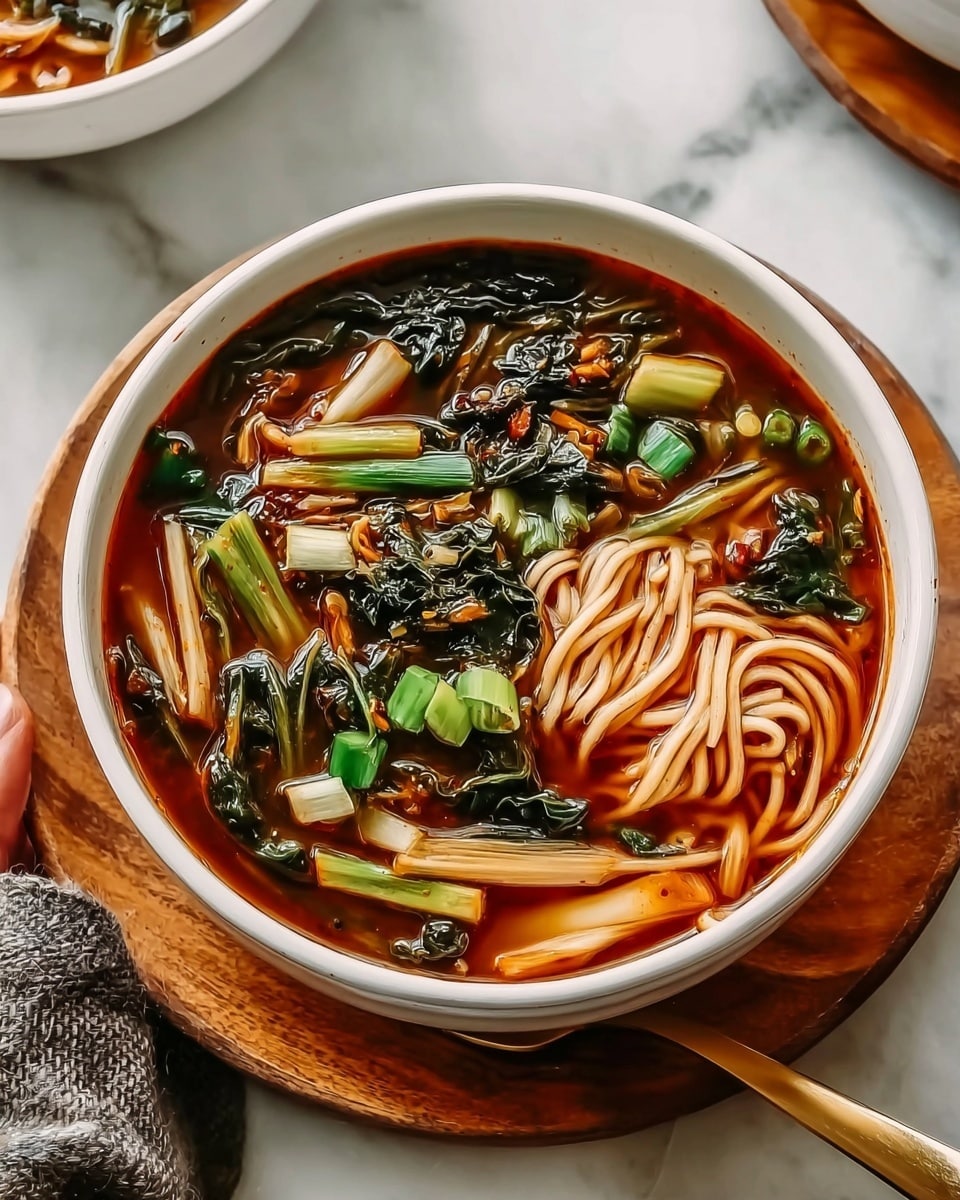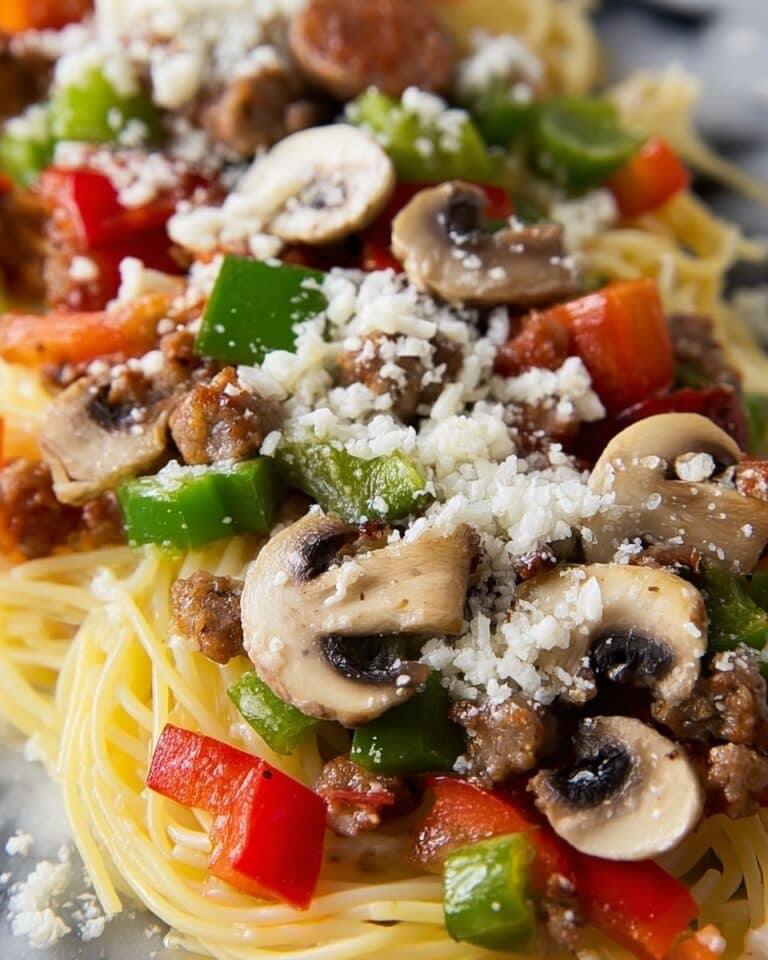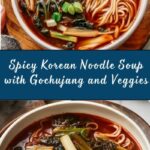Spicy Korean Noodle Soup Recipe
If you’ve ever craved a bowl of comfort that’s bold, vibrant, and packed with layers of flavor, this Spicy Korean Noodle Soup Recipe is about to become your new go-to. Imagine a steaming mix of tender noodles soaking up a broth infused with rich gochujang, fragrant garlic, and fresh ginger, brightened by crisp vegetables and finished with a silky soft-boiled egg. It’s the perfect blend of spicy, savory, and satisfying, all in one bowl. Whether it’s a chilly evening or you just want to try something exciting in your kitchen, this Korean classic will warm you up from the inside out and keep you coming back for more.

Ingredients You’ll Need
The magic of this Spicy Korean Noodle Soup Recipe starts with a few simple, thoughtful ingredients that each play a crucial role. From the spicy depth of gochujang to the fresh crunch of napa cabbage, every element adds taste, texture, or color to make the soup unforgettable and nourishing.
- 6 cups low-sodium chicken or vegetable broth: The flavorful base that makes your soup comforting without being overly salty.
- 2 tablespoons gochujang (Korean red chili paste): Adds just the right kick of heat and a subtle hint of sweetness.
- 1 tablespoon soy sauce: Enhances umami and brings balance to the broth.
- 1 tablespoon sesame oil: Provides a rich, nutty aroma and depth.
- 2 teaspoons rice vinegar: Brightens the flavors with a touch of acidity.
- 4 garlic cloves, minced: Infuses the soup with a warm, pungent taste.
- 1 teaspoon grated fresh ginger: Adds a zesty freshness and spiciness.
- 1 cup shiitake mushrooms, sliced: Gives an earthy savoriness and meaty texture.
- 1 cup napa cabbage, chopped: Crunchy and mildly sweet, perfect for texture contrast.
- 1 medium carrot, julienned: Brings subtle sweetness and a pop of color.
- 1 small zucchini, julienned: Adds freshness and balances the spice.
- 6 ounces Korean wheat noodles or ramen noodles: The chewy, slurp-worthy heart of the dish.
- 2 green onions, sliced: Used both in the soup and as garnish for a crisp bite.
- Soft-boiled egg per serving (optional): Creamy richness that complements the spicy broth perfectly.
- Toasted sesame seeds: A final sprinkle for a nutty crunch and beautiful presentation.
How to Make Spicy Korean Noodle Soup Recipe
Step 1: Sauté the Aromatics
Start by warming sesame oil in a large pot over medium heat. Toss in the minced garlic and freshly grated ginger, sautéing them for about a minute. This step is all about building that fragrant foundation, making sure your broth will have depth and warmth right from the start.
Step 2: Add the Gochujang and Soy Sauce
Next, stir in the gochujang and soy sauce. Give it a minute to cook, letting those spicy, savory flavors meld and deepen. This is what sets your soup apart, giving it that signature kick and complexity.
Step 3: Pour in the Broth and Bring to a Boil
Pour in the chicken or vegetable broth, turning up the heat so it reaches a gentle boil. This is where everything starts to come together — the spicy paste, umami soy sauce, and aromatic base combining with the liquid to create a beautiful, flavorful broth.
Step 4: Add the Vegetables and Simmer
Once boiling, toss in the shiitake mushrooms, napa cabbage, carrot, and zucchini. Reduce the heat and let the soup simmer for 10 to 12 minutes until the vegetables soften just right, maintaining a slight crunch that keeps each spoonful interesting and fresh.
Step 5: Prepare the Noodles
While your broth is simmering, cook the noodles according to their package instructions. Then drain them well and set aside. These noodles will soon soak up all the spicy goodness when combined with the broth.
Step 6: Finish with Rice Vinegar and Adjust Seasoning
Stir in the rice vinegar for a bright, tangy note that lifts the soup’s flavors beautifully. Taste the broth and adjust the seasoning if needed — a pinch more soy sauce or gochujang might be just the thing depending on your preference.
Step 7: Assemble and Serve
Divide the noodles into serving bowls, then ladle the hot soup and veggies over them. Top each bowl with a soft-boiled egg if you’re using it, then sprinkle sliced green onions and toasted sesame seeds on top to finish. The result? Pure, delivering on every level, Spicy Korean Noodle Soup Recipe bliss.
How to Serve Spicy Korean Noodle Soup Recipe

Garnishes
Garnishes elevate your soup from good to incredible. Sliced green onions bring a fresh crunch, while toasted sesame seeds add nuttiness and texture. The optional soft-boiled egg introduces creamy richness that beautifully soothes the spicy broth. Don’t be shy about customizing with additional chili flakes if you like more heat!
Side Dishes
This soup pairs perfectly with classic Korean sides like kimchi for a fermented kick or pickled radish to cut through the richness. You can also enjoy it alongside steamed rice or Korean pancakes for a fuller, more satisfying meal.
Creative Ways to Present
For dinner parties or special occasions, consider serving the soup in rustic bowls topped with edible flowers or thinly sliced chili rings. Arrange the vegetables and eggs artfully on top before ladling broth to highlight the vibrant colors. It’s as pleasing to the eyes as it is to the palate.
Make Ahead and Storage
Storing Leftovers
Store any leftover soup in an airtight container in the refrigerator for up to 3 days. Keep the noodles separate if you can to prevent them from getting too soft or mushy. When ready to eat, simply reheat the broth and vegetables, then add freshly cooked noodles for the best texture.
Freezing
You can freeze the broth and vegetables portion of the soup without the noodles for up to 2 months. Thaw overnight in the refrigerator and reheat gently on the stove. Add freshly cooked noodles at serving time to keep your soup tasting fresh and vibrant.
Reheating
Reheat the soup gently on the stove over medium-low heat to prevent boiling off the flavors. If stored separately, cook noodles fresh and combine just before serving to maintain their ideal texture and chewiness.
FAQs
Can I make this Spicy Korean Noodle Soup Recipe vegetarian?
Absolutely! Simply use vegetable broth instead of chicken broth and skip the soft-boiled egg or replace it with tofu for protein. The gochujang and vegetables pack plenty of flavor to make this a satisfying vegetarian meal.
How spicy is this soup?
The heat level of this Spicy Korean Noodle Soup Recipe can be adjusted easily by varying the amount of gochujang you add. Start with less if you prefer milder spice, and add more gradually to suit your taste buds perfectly.
What kind of noodles should I use?
Korean wheat noodles are traditional, but ramen noodles work wonderfully too. Their chewy texture pairs well with the broth and vegetables. You can even use udon or soba noodles for a different but delicious twist.
Can I add protein to this soup?
Yes! Feel free to add cooked chicken, shrimp, or tofu to make the soup heartier. Add these in during the simmering step or just before serving to keep them tender and flavorful.
Is this soup good for meal prep?
Definitely. The broth and vegetables hold up well for several days when stored properly. Just cook noodles fresh with each serving so they stay perfectly chewy and avoid becoming mushy.
Final Thoughts
There’s something truly irresistible about a bowl of Spicy Korean Noodle Soup Recipe that warms you both inside and out. With its balance of spice, fresh veggies, and satisfying noodles, it’s a dish you absolutely have to try. Whether you’re a seasoned fan of Korean cuisine or just dipping your toes in, this recipe is approachable and memorable. So grab your ingredients, spark up your stove, and get ready for a delicious experience you’ll want to share again and again!
Print
Spicy Korean Noodle Soup Recipe
- Total Time: 35 minutes
- Yield: 4 servings 1x
- Diet: Vegetarian
Description
Experience the rich, spicy flavors of Korea with this comforting Spicy Korean Noodle Soup. Made with a savory broth infused with gochujang, garlic, and ginger, this soup is loaded with nutritious vegetables and tender noodles. Topped with a soft-boiled egg and garnished with sesame seeds and green onions, it’s a wholesome, flavorful meal perfect for any day.
Ingredients
Broth and Seasonings
- 6 cups low-sodium chicken or vegetable broth
- 2 tablespoons gochujang (Korean red chili paste)
- 1 tablespoon soy sauce
- 1 tablespoon sesame oil
- 2 teaspoons rice vinegar
Aromatics
- 4 garlic cloves, minced
- 1 teaspoon grated fresh ginger
Vegetables
- 1 cup shiitake mushrooms, sliced
- 1 cup napa cabbage, chopped
- 1 medium carrot, julienned
- 1 small zucchini, julienned
Noodles & Garnishes
- 6 ounces Korean wheat noodles or ramen noodles
- 2 green onions, sliced
- Soft-boiled egg, 1 per serving (optional)
- Toasted sesame seeds, for garnish
- Additional sliced green onions, for garnish
Instructions
- Sauté Aromatics: In a large pot, heat the sesame oil over medium heat. Add the minced garlic and grated ginger, sautéing for about 1 minute until fragrant to develop a flavorful base.
- Add Seasonings: Stir in the gochujang and soy sauce, cooking for another minute. This step deepens the spicy and savory flavors of the soup.
- Simmer Vegetables: Pour in the broth and bring to a boil. Add the shiitake mushrooms, napa cabbage, carrot, and zucchini. Reduce heat and let the mixture simmer for 10 to 12 minutes until the vegetables are tender and the flavors meld.
- Cook Noodles: While the soup simmers, prepare the noodles according to package instructions. Drain and set aside to be added later.
- Finish Soup: Stir in rice vinegar for brightness, and taste the broth to adjust seasoning as needed.
- Assemble Bowls: Divide the cooked noodles into serving bowls. Ladle the hot soup over the noodles, ensuring each bowl gets a good mix of broth and vegetables.
- Garnish and Serve: Top each bowl with a soft-boiled egg if desired. Sprinkle with sliced green onions and toasted sesame seeds for extra flavor and texture. Serve hot and enjoy.
Notes
- For added protein, consider adding tofu, cooked chicken, or shrimp.
- Adjust the amount of gochujang to control the spice level according to your preference.
- To keep this soup vegetarian, use vegetable broth and omit the egg topping.
- Prep Time: 15 minutes
- Cook Time: 20 minutes
- Category: Soup
- Method: Stovetop
- Cuisine: Korean






